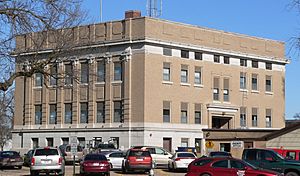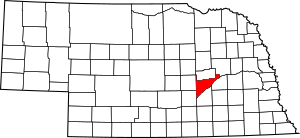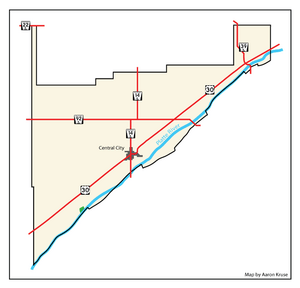Merrick County, Nebraska facts for kids
Quick facts for kids
Merrick County
|
|
|---|---|
| County of Merrick | |

Merrick County Courthouse in Central City
|
|

Location within the U.S. state of Nebraska
|
|
| Country | |
| State | |
| Established | November 4, 1858 |
| Organized | April 18, 1864 |
| Named for | Elvira Merrick |
| County seat | Central City |
| Largest city | Central City |
| Area | |
| • Total | 494 sq mi (1,280 km2) |
| • Land | 485 sq mi (1,260 km2) |
| • Water | 9.6 sq mi (25 km2) 1.9% |
| Highest elevation | 1,880 ft (570 m) |
| Lowest elevation | 1,345 ft (410 m) |
| Population | |
| • Estimate
(2021)
|
7,665 |
| • Density | 16.3/sq mi (6.3/km2) |
| Time zone | UTC−6 (Central) |
| • Summer (DST) | UTC−5 (CDT) |
| Area code | 308 |
| FIPS code | 31121 |
| GNIS feature ID | 835882 |
| Website | merrickcounty.ne.gov |
Merrick County is a county in the U.S. state of Nebraska. As of the 2020 United States Census, the population was 7,668. Its county seat is Central City.
Merrick County is part of the Grand Island, NE Metropolitan Statistical Area.
In the Nebraska license plate system, Merrick County is represented by the prefix 46 (it had the 46th-largest number of vehicles registered in the state when the license plate system was established in 1922).
Contents
History
Merrick County was formed in 1858, and was organized in 1864. It was named for Elvira Merrick, the maiden name of the wife of territorial legislator Henry W. DePuy, who introduced the bill that created the county.
When first formed, the county was bounded on the south by the Platte River, and by straight lines on the north, east, and west; enclosing 180 square miles (470 km2) of the Pawnee Reservation, which had been established in 1857. In 1873, the state legislature removed these reservation lands from the county, leaving it with a jagged northern border from which narrow panhandles extended northward from the northeast and northwest corners. In 1897, the Pawnee Reservation became Nance County.
Geography
The terrain of Merrick County is low rolling plains, sloping to the east and northeast. Most of the area is under cultivation. The Platte River flows northeastward along the southeast border line of the county. A smaller drainage, Prairie Creek, parallels the river, flowing northeastward through the center of the county before discharging into the Platte River northeast of Merrick County. The county has an area of 494 square miles (1,280 km2), of which 485 square miles (1,260 km2) is land and 9.6 square miles (25 km2) (1.9%) is water.
Major highways
Adjacent counties
- Platte County – northeast
- Polk County – east
- Hamilton County – south
- Hall County – southwest
- Howard County – west
- Nance County – north
Demographics
| Historical population | |||
|---|---|---|---|
| Census | Pop. | %± | |
| 1860 | 109 | — | |
| 1870 | 557 | 411.0% | |
| 1880 | 5,341 | 858.9% | |
| 1890 | 8,758 | 64.0% | |
| 1900 | 9,255 | 5.7% | |
| 1910 | 10,379 | 12.1% | |
| 1920 | 10,763 | 3.7% | |
| 1930 | 10,619 | −1.3% | |
| 1940 | 9,354 | −11.9% | |
| 1950 | 8,812 | −5.8% | |
| 1960 | 8,363 | −5.1% | |
| 1970 | 8,751 | 4.6% | |
| 1980 | 8,945 | 2.2% | |
| 1990 | 8,049 | −10.0% | |
| 2000 | 8,204 | 1.9% | |
| 2010 | 7,845 | −4.4% | |
| 2020 | 7,668 | −2.3% | |
| 2021 (est.) | 7,665 | −2.3% | |
| US Decennial Census 1790-1960 1900-1990 1990-2000 2010-2013 |
|||
As of the 2000 United States Census, there were 8,204 people, 3,209 households, and 2,307 families in the county. The population density was 17 people per square mile (6.6 people/km2). There were 3,649 housing units at an average density of 8 units per square mile (3.1 units/km2). The racial makeup of the county was 98.32% White, 0.22% Black or African American, 0.10% Native American, 0.21% Asian, 0.01% Pacific Islander, 0.67% from other races, and 0.48% from two or more races. 2.05% of the population were Hispanic or Latino of any race.
There were 3,209 households, out of which 33.30% had children under the age of 18 living with them, 61.10% were married couples living together, 6.50% had a female householder with no husband present, and 28.10% were non-families. 25.00% of all households were made up of individuals, and 13.10% had someone living alone who was 65 years of age or older. The average household size was 2.51 and the average family size was 2.99.
The county population contained 27.50% under the age of 18, 6.40% from 18 to 24, 24.70% from 25 to 44, 23.80% from 45 to 64, and 17.50% who were 65 years of age or older. The median age was 39 years. For every 100 females, there were 95.90 males. For every 100 females age 18 and over, there were 94.90 males.
The median income for a household in the county was $34,961, and the median income for a family was $39,729. Males had a median income of $26,998 versus $19,828 for females. The per capita income for the county was $15,958. About 7.00% of families and 8.90% of the population were below the poverty line, including 9.70% of those under age 18 and 9.20% of those age 65 or over.
Communities
City
- Central City (county seat)
Villages
Census-designated place
Unincorporated communities
Townships
- Central
- Chapman
- Clarksville
- Lone Tree
- Loup
- Mead
- Midland
- Prairie Creek
- Prairie Island
- Silver Creek
- Vieregg
See also
 In Spanish: Condado de Merrick para niños
In Spanish: Condado de Merrick para niños


